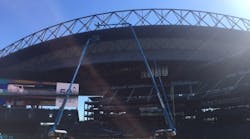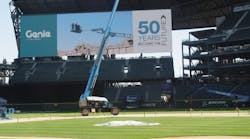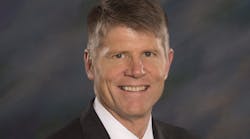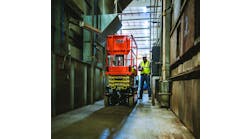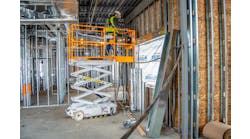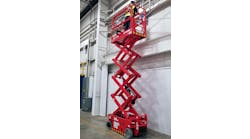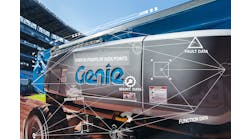RER interviews Genie president Matt Fearon about advances in hybrid technologies, upcoming ANSI standards, safety enhancements, and much more.
RER: What are the most important technological developments in aerial work platforms in the past year or so?
Fearon: The biggest technological advancements in AWP in the past year have been with hybrid technologies. Creating an AWP machine that is capable of working productively in rough terrain environments, as well as working in quiet, emission-free environments, is a challenge. One of the keys to success in this type of machine is the ability to transition seamlessly – going from a drive performance as offered by a full diesel power unit to a quiet electric machine.
In addition, aerial OEMs, including Genie, have had to be creative with managing the weight of the machine, while not giving up on key specifications of height and outreach, balanced with power output needed from hybrid technology to run the machine. We have also had to design high-efficiency components, to provide a machine with rough terrain capability that is not too heavy. When designed well, hybrid technology can be made to work well in a rough terrain machine. These technological advances are keys to the success and growth of the AWP market.
What do you expect in the coming year?
In the coming year, aerial OEMs will be redesigning machines to comply with the updated ANSI/CSA standards and to meet the upcoming recertification requirements. These requirements are fundamentally changing some features of AWPs; for example, platform load control will be required, which means that aerials will be required to continuously check the weight in the platform and disable the functioning if the load is above the platform load limit.
In addition, drive and certain boom functions will be required to be disabled when the machine is attempting to operate out of the unit’s slope limit. There will also be provisions for indoor-only use aerials, where these particular units are not subject to wind loads during operation. And finally, terminology and training requirements will be modified. These regulatory changes will have a significant impact on the market, and it is up to the OEMs, like Genie, to focus not only on meeting the new standards but also ensuring the customer is educated on the changes. It is our goal that the impacts of the changes are seamless.
What are the most compelling developments in the low-level access area? Is this a growing market segment?
The low level access portion of the AWP market appears to be gaining momentum as companies continue to look for alternatives to ladders. We don’t expect a huge shift, but it is a trend we are watching.
Sum up what your company has done technologically recently that is unique?
Genie has continued to innovate, as we have for the last 50 years. The key to success with our technology innovations has been to closely engage with our customers to meet their safety and jobsite needs. For example, we recently introduced an accessory called the Fall Arrest Bar. We worked closely with end users, safety professionals and rental customers to design and manufacture an accessory that allows operators to work outside the platform. This allows working safely on roof tops or around obstacles, allowing the operator to exit the platform and move freely within a set dimension.
We have also innovated in the hybrid area, launching the Genie Z-60/37FE (fuel-electric) model this year with rough-terrain capabilities. To accomplish this, we extensively designed and tested efficient AC drive motors and reduced weight in the machine, resulting in a powerful rough terrain machine that can also be seamlessly switched to an indoor, emission-free machine. This allows our customers to have flexibility in their fleet mix of equipment, and it results in a versatile, high performance machine for the end user. In addition, the machine is designed to be able to run on drained batteries, and it can bulk charge the batteries in four hours. This feature especially helps with uptime of the machine, allowing excellent job site usage, bringing maximum ROI to rental companies.
What is likely to be new at the 60, 80, and 100 foot levels?
At Genie, we believe productivity will be one of the drivers of future machines, especially at the 60-, 80- and 100-ft heights. Jobsite speed and efficiency are critical to keeping construction and industrial costs controlled – and the use of large machinery is one of the significant construction costs. In addition, accessories that solve specific job site requirements and keep operators safe are extremely important. For example, Genie offers an Operator Protective Alarm and an Operator Protective Structure – both are secondary protective devices that provide additional protection for operators from overhead obstacles. These features are critical for all jobs with work at height.
We have seen tremendous growth in the AWP segment. Still I’m sure there are some industries that are open for growth, and geographic regions where there is ample room for adoption of AWPs. What are some of your thoughts about this?
Genie agrees that there is room for the AWP segment to grow, and this is especially true in some regions of the world where AWPs are just becoming commonplace. As with any construction trend, there has to be a business need to change their processes, and AWPs offer greater productivity than many of the other work-at-height solutions (examples: ladders and scaffolding). As with any change, it will take time for operators to gain a level of comfort with the machines. This is why Genie is engaged in these regions of the world on training and educating the construction base in the overall benefits of AWPs, as well as familiarizing them with operating and maintaining AWPs.
There have been great advances in safety in the aerial industry. What are some concerns in the safety arena?
Genie truly believes that no job or timeline is worth an injury. One of the first areas to focus on to improve jobsite safety is training. Operator awareness of their surroundings and understanding of the value of a moment’s assessment of the environment are critical to site safety. Genie’s training courses, including our Genie Lift Pro Online Operator Training, focus on this, as well as take the operator to the next level of understanding of electrical and physical hazards.
Added to Genie’s training offerings are standard features that help maintain jobsite safety. These are features such as intuitive control systems, so the motion of the machine is very clear to the operator, easy entry and exit to the machine, which limits trip hazards, and eight standard lanyard attachments in the platform. Genie offers all of these, as well as secondary protective devices such as the fall arrest bar, operator protective alarm and operator protective structure, to add additional layers on protection particularly on certain jobsites.
How would you assess technological advancements in electric units, hybrids and alternative fuels?
Advancements are occurring all the time in hybrid machines with both alternative fuels, as well as electric/diesel combinations. The key to success will be achieving the balance of performance, maintenance and repair with acquisition cost. Genie believes the flexibility these machines have to work both indoors and outdoors will continue to grow in the market place as long as the performance of these machines is on par with customers’ expectations/market demands.
